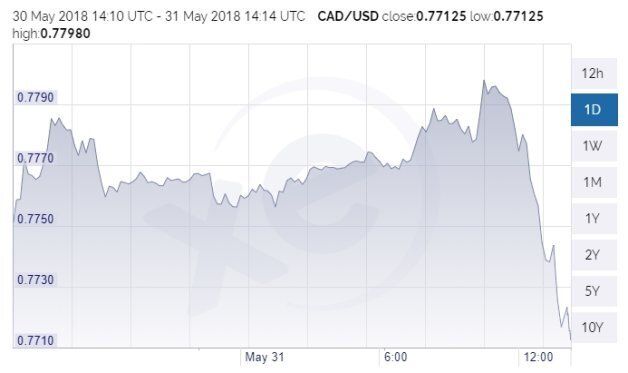
The loonie dropped by nearly a cent in a matter of hours Thursday morning, amid news that the U.S. is imposing steel and aluminum tariffs on Canada, and a report showing the country's economy is growing more slowly than expected.
The U.S. Commerce Department announced Thursday morning that Canada would no longer be exempt from steel and aluminum tariffs imposed on numerous countries by the Trump administration. As of Friday, Canadian steel sent to the U.S. will be subject to a 25-per-cent tariff, while aluminum will be slapped with a 10-per-cent tariff.
That news came shortly after a report from Statistics Canada showing growth slowing in the first quarter of this year, to 1.3 per cent at an annual pace, from 1.8 per cent in the last quarter of 2017. The numbers disappointed analysts, who had been looking for growth of around 1.8 per cent.

Statistics Canada placed the blame on the slowdown in the housing market. The new "stress tests" for mortgage borrowers have effectively reduced purchasing power by 20 per cent, leading to a slowdown in sales in many markets this spring.
Housing investment fell by 1.9 per cent in the quarter, the steepest drop since 2009, when the country was in the midst of the financial crisis, StatCan data showed.
The Canadian dollar fell to 77.1 cents U.S. as of 10 a.m. ET Thursday morning, down from a peak of 77.9 cents U.S. earlier in the day.
The dropping currency is a sign that traders have lost some faith in Canada's economy amid growing concerns about the country's competitiveness. Canada is the largest foreign supplier of steel to the U.S., accounting for 17 per cent of its steel imports in 2017, according to U.S. trade figures.
Watch: Trump to impose tariffs on steel and aluminum from Canada, Mexico, European Union
But the weakness didn't begin on Thursday. The Canadian dollar had already hit a two-month low against the U.S. dollar earlier this week, falling with the price of oil.
According to analysts, many traders are betting that the U.S. will have higher interest rates than Canada in the months and years ahead, making the U.S. dollar a more attractive investment.
Perhaps ironically, a lower loonie actually helps Canadian exports, as it lowers their price on the global market. However, the one-per-cent drop in the loonie on Thursday isn't quite enough to offset the 25-per-cent tariff on Canadian steel.
Earlier on HuffPost Canada:
Some analysts see even more weakness ahead for the loonie, due to Canada's declining competitiveness on exports.
"Since the turn of the millennium, other than in the post-recession bounce-back, Canada has been an also-ran in the race for global and U.S. markets," CIBC economists Avery Shenfeld and Royce Mendes wrote in the report.
"What's been lacking are ribbon-cutting ceremonies at the new facilities — factories, labs and office towers — needed to expand export capacity."
The economists noted that a dropping loonie would make Canada more competitive, but "it would be better if Canada had other advantages to support export growth, rather than rely on a weak loonie that makes us less able to spend abroad."
If the country doesn't step up its export game, the loonie will drop to around 70 cents U.S. in the 2020s, the CIBC economists predicted.
To boost Canada's exports, they suggested "thinner" business regulations, lower corporate taxes and faster government approvals of projects.
CORRECTION: An earlier version of this article erroneously stated that Canadian imports would be boosted by a lower loonie. In fact, it is exports that benefit from a lower loonie.
Also on HuffPost: